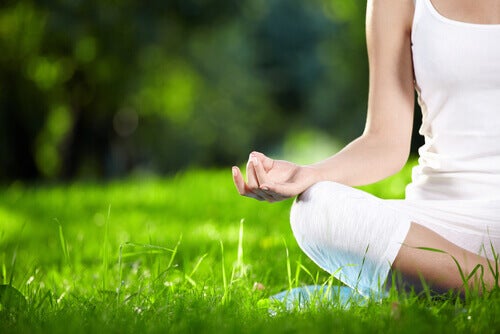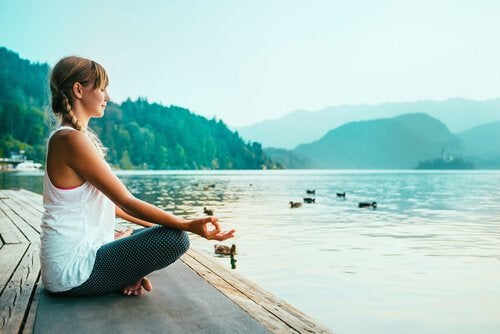(Exploring The Mind) Resorting to mindfulness techniques can help you be more flexible, control your attention, and face any situations that come your way.
Related 6 Ways to Use Mindfulness to Ease Difficult Emotions
by Staff Writer, September 29th, 2019
Mindfulness is the English translation of the Pali word “sati“, which basically means something along the lines of “consciousness, attention, and memory”. In today’s article, we’re going to show you two important mindfulness strategies and techniques.
Professor Jon Kabat-Zinn is a pioneer in bringing mindfulness to the West, especially in a clinical sense. He says that “Mindfulness means paying attention in a particular way: on purpose, in the present moment, and nonjudgmentally”.
In other words, you need to radically accept the present moment, without making judgments. That means being open to experiencing and living with your feelings, mental occurrences, and circumstances, whether they’re positive or negative. As for the negative side of things, the goal is to expose yourself to them without taking any direct action on the experience.
[the_ad_group id=”3118″]
This is very similar to the Buddhist idea of detachment. Buddhists believe you’re supposed to disconnect yourself and observe your experiences, thoughts, and emotions from afar.
Some of the most important things you can do attitude-wise regarding mindfulness are not to judge, be patient, have a “beginner’s mind”, not let past experiences influence you, be confident, not over-exert yourself, and accept or see things the way they really are.

Mindfulness strategies and techniques
Bishop (2002) put forth a detailed list of some components of mindfulness that includes things such as self-regulating your attention, orienting yourself towards your experiences in the present moment, curiosity, openness, and acceptance.
Self-regulating your attention
This strategy involves keeping your attention on your immediate experiences. It means not trying to take control. If you do that, you can reach a better understanding of the things going on in your mind in the present moment.
Buy Book Natural Pain Relief: How to Soothe and Dissolve Physical Pain with Mindfulness
[the_ad_group id=”3116″]
To do that, you’ll also need to work on some techniques and skills such as sustained attention, or the ability to stay focused for a long period of time. Also, you need to train yourself to change your attention and focus on breathing once you’ve picked out your thoughts, feelings, and sensations.
In this regard, you also need to learn not to follow or develop thoughts, feelings, or sensations. In other words, you have to avoid getting caught up in them. You simply should observe them and redirect your attention back to your breathing.
This is one of the mindfulness strategies that really involves the concept of the “beginner’s mind“. This is a way of thinking that means focusing on direct, pure attention. You have to take in the things you see in your environment as if it was the first time you were seeing them.
It means not looking at things through the filter of your experiences, beliefs, or expectations. Instead, you have to focus your attention on getting rid of that baggage.
Orienting yourself towards experience
The key here is to keep yourself curious. You have to open your mind so you can detect every thought, sensation, and feeling that arises. You have to be willing to let yourself think, feel, and experience things without trying to avoid them.
In other words, you need to approach your experiences with a curious attitude, no matter if they’re emotionally positive or negative. You have to radically accept experiences for what they are.
Buy Book Wherever You Go, There You Are: Mindfulness Meditation in Everyday Life
Other mindfulness strategies include focusing your attention on the present, radically accepting things without judgment, and freely choosing to actively engage in something (breathing or an activity, among other things).

The benefits of practicing mindfulness
These mindfulness strategies can help you get better at focusing your attention on whatever you want. It’s a great way to fight the robotic mindset we get into that’s characterized by automatic negative thoughts, which pop up in your mind without you even realizing it.
Since mindfulness helps people break out of that robotic cycle, it can help reduce physiological and somatic symptoms of various health problems. What it does is activate your parasympathetic nervous system. Thus, it can help you relax even more than traditional relaxation practices.
Some neuroscience studies say that it can also modify brain functions such as perception, superior cognitive processes, and emotional regulation (Cahn and Polich, 2006).
Last but not least, another amazing benefit of mindfulness is that it improves both emotional and physical health. All the evidence points to the fact that mindfulness is related to greater behavioral flexibility, which has a clear positive impact on your health. So what are you waiting for? Give mindfulness a try!
[the_ad id=”79984″]
Stillness in the Storm Editor: Why did we post this?
Consciousness is one of the most mysterious phenomena of all time. Scientists, philosophers, and mystics have been searching for the answer to the question, What is Consciousness? for most of human history. In modern times, the spiritual origins of consciousness are being replaced with a materialistic view, that awareness emerges as an additive property of electrical impulses in living things. Despite the fact this theory is assumed to be true, any self-respecting psychologist will tell you we have no idea what consciousness really is. The preceding article discusses consciousness, some of its properties, and possible origins. This is helpful to contemplate because, in the act of trying to understand the mysteries of consciousness, you develop critical thinking skills and stimulate your philosophic muscles, both which are immensely important for almost everything we do in life. Additionally, you’ll develop abstract thinking skills, the ability to explore intangible realities that govern material realms. With the power of an active mind capable of navigating the realities of consciousness, great leaps in personal attainment can be made along with preparing you for the Great Work of making this world a better place.
– Justin
Not sure how to make sense of this? Want to learn how to discern like a pro? Read this essential guide to discernment, analysis of claims, and understanding the truth in a world of deception: 4 Key Steps of Discernment – Advanced Truth-Seeking Tools.
Stillness in the Storm Editor’s note: Did you find a spelling error or grammar mistake? Send an email to corrections@stillnessinthestorm.com, with the error and suggested correction, along with the headline and url. Do you think this article needs an update? Or do you just have some feedback? Send us an email at sitsshow@gmail.com. Thank you for reading.
Source:
https://exploringyourmind.com/mindfulness-strategies-techniques/

Leave a Reply